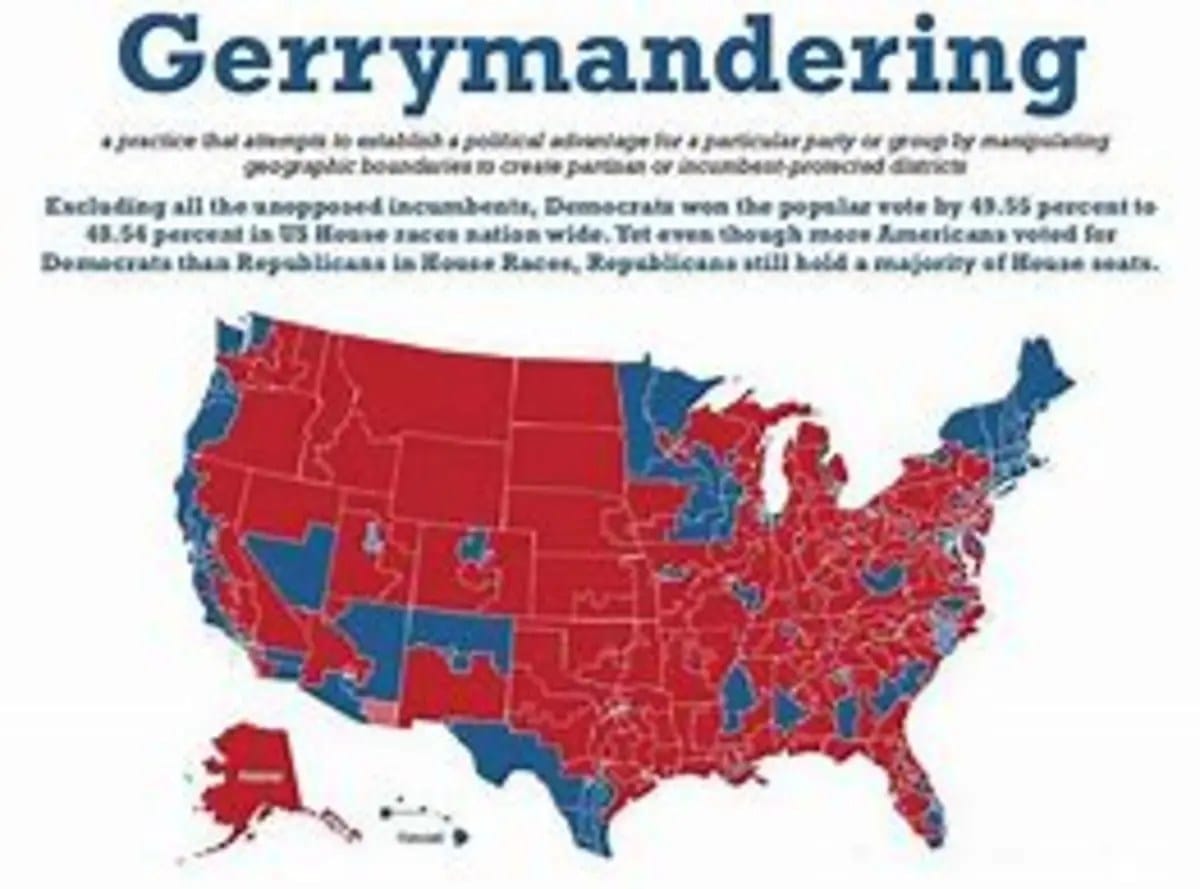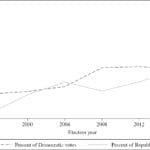Imagine your neighborhood divided like a jigsaw puzzle, its pieces rearranged to guarantee one group always wins. That’s the essence of gerrymandering—a manipulative practice warping the very fabric of fair elections. As we approach the 2024 election, the specter of gerrymandering looms large, threatening to undermine the core principles of democratic representation.
Could Gerrymandering Skew the 2024 Election?
Free and fair elections form the bedrock of a functioning democracy. However, the manipulation of electoral maps, known as gerrymandering, casts a long shadow over this fundamental right. In essence, it allows politicians to choose their voters rather than the other way around.
Similar to how a child might strategically divide a pizza to claim the largest slice, politicians can manipulate the boundaries of voting districts to give their party an unfair advantage. By packing opposition voters into a few concentrated districts, their influence is minimized, while the dominant party’s supporters are spread across multiple districts to maximize their chances of winning.
This practice, while not new, has taken on heightened significance in recent years. The redistricting cycle following the 2020 Census resulted in a wave of controversial maps, many of which appear designed to benefit one party over another. The increasing sophistication of mapping technology has further enabled this manipulation, allowing for the precise targeting of voter demographics.
The issue is particularly concerning given the rise of “racial gerrymandering,” a practice aimed at minimizing the voting power of minority groups. This echoes a dark chapter in American history, and recent legal developments have sparked concern that this practice may become more prevalent.
The True Cost of Gerrymandering: Beyond Election Results
While the extent of gerrymandering’s influence on national elections is a subject of ongoing debate, its impact on the fabric of American democracy is undeniable. Even if it doesn’t always determine the ultimate winner, gerrymandering erodes trust in the system, undermines representation, and fuels political extremism.
Imagine going to a restaurant and being told you can only order what the chef has pre-selected. While you might not starve, you’d likely feel frustrated and unheard. This is the experience of countless voters in gerrymandered districts. When people believe their vote doesn’t matter, it breeds cynicism, discourages participation, and creates a sense of disenfranchisement.
Moreover, gerrymandering undermines accountability. Politicians in “safe seats,” secured through manipulated district lines, have less incentive to listen to their constituents or compromise with their opponents. This lack of accountability can lead to a decline in the quality of representation as elected officials become less responsive to the needs of the people they were elected to serve.
Perhaps most alarmingly, gerrymandering can fuel political extremism. In districts carefully drawn to favor a particular party, candidates often cater to the most extreme elements of their base to secure re-election. This dynamic can lead to a political climate characterized by gridlock, polarization, and the inability to address pressing issues facing the nation.
The historical legacy of gerrymandering, particularly its use as a tool to suppress minority voting power, adds another layer of urgency to this issue. Concerns about racial gerrymandering persist, as communities of color continue to face efforts to dilute their voting strength and limit their representation in government.
See the latest update on our Wahya Fire that struck last week and caused devastation to the community.
How Gerrymandering Erodes Competitive Elections
Imagine a board game where one player gets to rearrange the board before the game begins. This is the essence of gerrymandering—it allows politicians to manipulate the rules of the game to give themselves an unfair advantage.
By employing tactics like “packing” (concentrating opposition voters in a few districts) and “cracking” (spreading opposition voters across multiple districts to dilute their voting power), gerrymandering undermines the principle of one person, one vote. It allows politicians to pick their voters, effectively predetermining the outcome of many elections.
The consequences are far-reaching. When elections lack genuine competition, it discourages voter participation. Why bother voting if the outcome seems preordained? This leads to lower voter turnout, particularly among those who feel their voices are being silenced by the system.
Moreover, uncompetitive elections can contribute to a decline in the quality of representation. When politicians don’t have to worry about facing a genuine challenge, they are less likely to engage with voters from across the political spectrum or consider diverse perspectives. This can lead to a disconnect between elected officials and the needs of their constituents.
The Impact on Voter Representation
Gerrymandering distorts the very idea of representative democracy. It creates a system where politicians are accountable not to the people they represent, but to the partisan interests that drew the lines in their favor. This has a profound impact on the way our government functions and the policies that are enacted.
When communities are carved up and their voting power is diluted, it diminishes their ability to elect representatives who reflect their interests and values. This can lead to a disconnect between the needs of the people and the priorities of those in power.
The long-term consequences are significant. Apathy, cynicism, and distrust in government grow when people feel their voices are not being heard or their votes do not matter. This undermines the legitimacy of our democratic institutions and erodes the fabric of our society.
Find the results of the WMS Auction held recently, which attracted a huge crowd of bidders with great deals on offer.
Can We Fix It? Solutions to Combat Gerrymandering
While the problem of gerrymandering is complex and deeply entrenched, there is hope. Across the country, citizens, activists, and reformers are fighting back with innovative solutions and a renewed commitment to fair elections.
Here are some of the most promising avenues for reform:
1. Independent Redistricting Commissions:
One of the most effective ways to combat gerrymandering is to take the map-drawing process out of the hands of partisan legislatures and entrust it to independent commissions. These commissions, typically composed of experts and citizens, are tasked with drawing fair and impartial district boundaries that prioritize equal representation.
2. Legal Challenges:
Courts have played a vital role in striking down gerrymandered maps that violate voting rights or constitutional principles. Numerous legal challenges are underway across the country, with some notable successes in recent years. These legal battles are crucial for ensuring that electoral maps adhere to democratic norms and protect the right to vote.
3. Citizen Action and Advocacy:
Grassroots movements and citizen-led organizations are at the forefront of the fight against gerrymandering. From educating voters to organizing protests to supporting legal challenges, citizen action is crucial for raising awareness, mobilizing public pressure, and holding elected officials accountable.
4. Technological Solutions:
Technology is emerging as a powerful tool for combating gerrymandering. Researchers are developing algorithms and software programs that can analyze electoral maps for signs of manipulation and generate fairer alternatives. These technologies offer the potential for greater transparency and objectivity in the redistricting process.
Widespread Gerrymandering: A Deep Dive into Its History and Evolution
The practice of gerrymandering is as old as the United States itself, its roots intertwined with the nation’s complex history of political power struggles and the fight for equal representation.
The term “gerrymander” originated in 1812 when Massachusetts Governor Elbridge Gerry approved a partisan redistricting plan. This plan, designed to benefit Gerry’s party, resulted in a district so contorted that it resembled a salamander, leading to the term “Gerry-mander.”
Over time, gerrymandering evolved alongside societal changes, political strategies, and technological advancements. From crudely drawn maps favoring landed elites to sophisticated data-driven manipulations targeting specific demographics, the practice has adapted to maintain its grip on power.
Key Points:
Gerrymandering:
- Involves manipulating voting district lines to benefit one political party.
- Concentrates opponents’ voters in a few districts while spreading their own voters across multiple districts to secure more wins.
2024 Election Concerns:
- Redistricting following the 2020 Census resulted in potentially biased maps.
- Concerns about “racial gerrymandering” aimed at suppressing minority voting power.
Solutions:
- Establishing independent commissions to draw impartial electoral maps.
- Pursuing legal challenges against discriminatory or unfair maps.
- Raising public awareness and supporting reform efforts.
Importance:
- Gerrymandering compromises fair elections, a cornerstone of a healthy democracy.
- It undermines the principle of equal representation and erodes public trust in government.
- It perpetuates a history of discrimination and disenfranchisement.
The fight against gerrymandering is a battle for the soul of American democracy. It is a fight to ensure that every vote counts, that every voice is heard, and that the government truly represents the will of the people. By understanding the issue, supporting reform efforts, and holding our elected officials accountable, we can create a more just and equitable democracy for all.
- Unlocking 2-Letter Words with U: The Definitive Guide - April 4, 2025
- Unlock Words with the Letters THREE: Top Unscramble Tools 2025 - April 4, 2025
- Master Scrabble: X & Z Words for High Scores - April 4, 2025
















